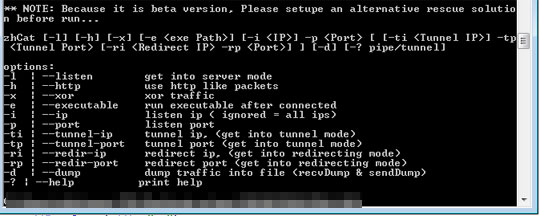HKTL_ZHCAT.GA
Trojan.Zelocat (Symantec), Riskware/ZhCat (Fortinet), Tool.ZhCat.1 (DrWeb)
Windows


Threat Type: Hacking Tool
Destructiveness: No
Encrypted: No
In the wild: Yes
OVERVIEW
Downloaded from the Internet
This hacking tool arrives on a system as a file dropped by other malware or as a file downloaded unknowingly by users when visiting malicious sites.
TECHNICAL DETAILS
12800 bytes
EXE
No
13 May 2014
Arrival Details
This hacking tool arrives on a system as a file dropped by other malware or as a file downloaded unknowingly by users when visiting malicious sites.
Other Details
This hacking tool does the following:
- Should be executed in command line window with parameters in order to run properly
- It accepts the following parameters as arguments:
- -l or --listen <- turns into server mode
- -h or --http <- perform http flood
- -x or --xor <- encrypt network traffic
- -e or --executable <- run executable after connecting
- -i or --ip <- listen to specific IP (no ip = all ip)
- -p or --port <- listen to specific port
- -ti or --tunnel-ip <- tunnel IP(get into tunnel mode)
- -tp or --tunnel-port <- tunnel port(get into tunnel mode)
- -ri or --redir-ip <- redirect IP(get into redirecting mode)
- -rp or --redir-port <- redirect port(get into redirecting mode)
- -d or --dump <- dump traffic into file (recvDump & sendDump)
- -? or --help <- print help
- Names the dump files as:
- {Current Directory}\sendDumpS.log
- {Current Directory}\sendDumpC.log
- {Current Directory}\recvDumpS.log
- {Current Directory}\recvDumpC.log
- Capable of logging its backdoor activities by executing the file, BackDoorLogger.exe - also detected as HKTL_ZHCAT.GA
- The BackDoorLogger.exe accepts the following parameters:
- -e - determines the zhcat executable's name
- -d - determines the log interval in milliseconds
- Displays the following when executed in a command line window:


SOLUTION
9.800
1.684.10
03 Dec 2015
1.685.00
04 Dec 2015
Step 1
Before doing any scans, Windows XP, Windows Vista, and Windows 7 users must disable System Restore to allow full scanning of their computers.
Step 2
Note that not all files, folders, and registry keys and entries are installed on your computer during this malware's/spyware's/grayware's execution. This may be due to incomplete installation or other operating system conditions. If you do not find the same files/folders/registry information, please proceed to the next step.
Step 3
Search and delete these files
- {Current Directory}\sendDumpS.log
- {Current Directory}\sendDumpC.log
- {Current Directory}\recvDumpS.log
- {Current Directory}\recvDumpC.log
Step 4
Scan your computer with your Trend Micro product to delete files detected as HKTL_ZHCAT.GA. If the detected files have already been cleaned, deleted, or quarantined by your Trend Micro product, no further step is required. You may opt to simply delete the quarantined files. Please check this Knowledge Base page for more information.
Did this description help? Tell us how we did.
